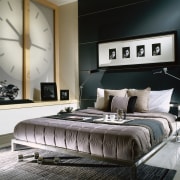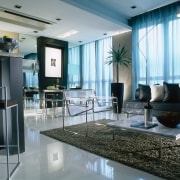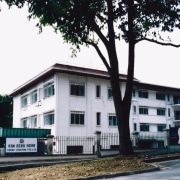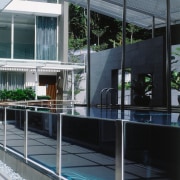Metamorphosis
Formerly a Chinese embassy, this low-rise building has undergone a full makeover to emerge as a trendy, urban apartment complex
Solid, functional architecture was commonplace in the 1950s. But while there was a straightforward practicality about many commercial premises, the design was often pedestrian.
The project featured here was a typical example. Originally the Chinese embassy in Singapore, the building was structurally sound, but visually unexciting. However, its simple lines made it well suited to apartment conversions, say architects William Ong and Rafael Pasaribu of Axis Architects Planners.
"The building had a lot of potential. It is in an attractive, upmarket area, and has a very prestigious address," says Ong. "Surrounding buildings are also low-rise apartments or bungalows."
"As the building was structurally intact, there was an opportunity to refurbish and remodel it to create a modern residential development that would appeal to a young market."
Ong says the developer, Heeton Holdings, wanted the DLV apartments to reinforce the concept of a trend-setting urban lifestyle, with places where residents could interact. To this end, the building needed to have an openness, and a sense that the development was a little out of the ordinary.
Although one wing of the original U-shaped building was rebuilt to accommodate a basement car park, most of the existing building was remodelled to create 25 apartments of varying sizes. As all the apartments overlook a recreational complex at the front, the designers have incorporated full-height glazing and new glazed balconies.
"The architecture reflects our desire to keep it open and simple," says Pasaribu. "Glass walls effectively borrow space from outside, enhancing a spacious feel. The apartments also reflect a more open lifestyle than we may have seen in the past the owners are quite happy to expose their living arrangements. However, in saying this, all apartments also have rooms that are more private. And residents can screen their apartments with plants on the balcony, if they wish."

The new facade creates a layered effect, thanks to trellis screens and concrete shear walls with cutouts for windows and platform-style balconies.
"The thin line of the large shear walls adds a light, almost feminine touch and prevents the building from looking too heavy," says Pasaribu.
A glass-walled swimming pool is concealed from the road by a solid granite wall, which also features cutouts allowing glimpses of landscaped areas. To provide shade, the pool is covered by a slightly skewed roof supported by stainless steel columns. These extend through the roof, enhancing a sculptural look.
Two roof gardens on the wings also feature shade roofs. When viewed from the side, the roofs are reminiscent of high diving platforms.
Other recreational areas include an outdoor seating area near the pool, and a gymnasium on the same level.
"Every little space has been utilised to maximise the tight site," says Pasaribu. "This also allows plenty of social interaction throughout the complex."
To complement the overall design philosophy, Ong says the apartment interiors needed to be chic and they also needed to convey a sense of something different.
"We wanted to create an environment where potential homeowners could expect the unexpected," he says. "But as well as providing a visual treat, each apartment had to be practical and liveable. Flexibility of use was essential."
Ong says careful space planning optimises the feel and use of each apartment.
"Mirrors and strategically planned lighting create the ambience and the spacious look that was required."
Ong says one show apartment was conceptualised as a swinging bachelor's pad. Here, materials such as leather, steel, stone and glass predominate.
"The aura of macho sleekness is obvious," says Ong. "There is a suggestion that rules do not apply. Colours are masculine and restrained, with black, white and shades of grey, and there are several state-of-the-art design items.
"What is inherent in the end result is something quite out of the ordinary. The apartment is very sophisticated, but it is also provocative a look that is in keeping with the overall theme of the complex."
Credit list
Architect
Construction company
Mechanical and electrical engineer
Earthworks
Roof
Balconies and balustrades
Paints
Security system
Lift services
Developer
Civil engineer
Quantity surveyor
Landscaping
Facade
Hardware
Flooring
Lighting
Signage
Swimming pool
Story by: Trendsideas
Home kitchen bathroom commercial design
Diving into nature
Classic looks, contemporary efficiency
Personality plus














